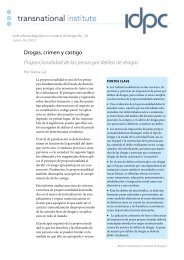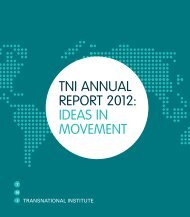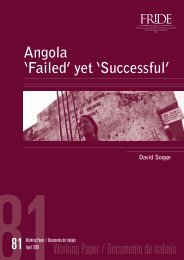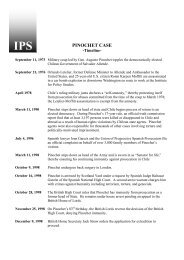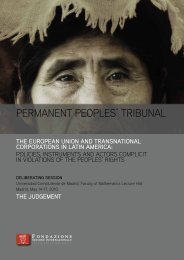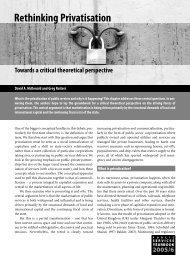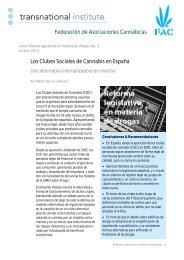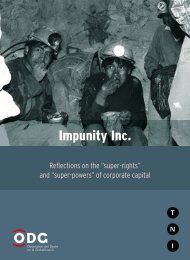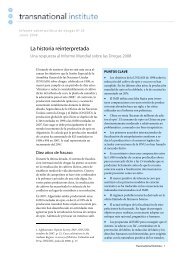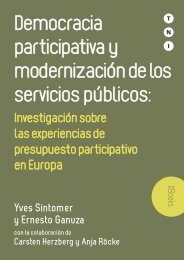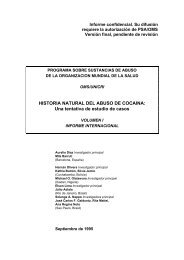New Interregionalism? The EU and East Asia
New Interregionalism? The EU and East Asia
New Interregionalism? The EU and East Asia
You also want an ePaper? Increase the reach of your titles
YUMPU automatically turns print PDFs into web optimized ePapers that Google loves.
322 Julie Gilsonoccur, by developing an ongoing agenda <strong>and</strong> a familiar pattern of terminology.This acts a as a shorth<strong>and</strong>, so that bilateral engagements can be spenton more targeted aims <strong>and</strong> focused bargaining. It is now accepted that <strong>East</strong><strong>Asia</strong> <strong>and</strong> the <strong>EU</strong> ‘matter’ to one another, as trade between them hassurpassed that of <strong>EU</strong>–US trade <strong>and</strong> as, during the 1980s <strong>and</strong> especially the1990s, regional trade agreements, as opposed to global ones, became “morepolitically desirable <strong>and</strong> feasible due to increased familiarity <strong>and</strong> comparablecultures, business practices <strong>and</strong> legal systems” (Yeung et al. 1999, 20).Role of RegionsSecond, <strong>and</strong> linked to the management of change, it reinforces the role ofregions as actors. Changes in the global economy <strong>and</strong> the scale of trans–border activities mean that regions have acted themselves into significance.However, those not in the interregional listings are excluded from the benefitsthat accrue from membership. <strong>The</strong> exclusion, not only of Australia <strong>and</strong><strong>New</strong> Zeal<strong>and</strong>, but also of indubitably ‘<strong>Asia</strong>n’ states such as India <strong>and</strong>Pakistan, demonstrates the development of a certain kind of economicallydeveloped <strong>East</strong> <strong>Asia</strong>. 17 Assumptions about the nature of this <strong>East</strong> <strong>Asia</strong> areeasily maintained, as <strong>EU</strong> Commissioner Manuel Marín noted: “We don’toperate like the Americans. In our search for compromise, we work almostlike the <strong>Asia</strong>ns” (Ton 1998). Linked to this point, the very notion of regionnessis embedded in the process of <strong>Asia</strong>–Europe interaction, as the <strong>East</strong><strong>Asia</strong>n regional self acts itself into being, in part through its acceptance as aregion by the <strong>EU</strong>. This is not to argue that <strong>East</strong> <strong>Asia</strong> has solely been definedthrough the interregional mechanisms of ASEM, rather to suggest that theexplicitly interregional process has been important in further delineating thecontours of <strong>Asia</strong>n regionness <strong>and</strong> in highlighting, albeit in a post factomanner, how processes such as the APT <strong>and</strong> regional financial initiativeshave become part of a regional discourse that is most visible in its interregionaliteration.Two–Way <strong>Interregionalism</strong>Third, the ASEM process provides the possibility for two–way interregionalism,whereby region–to–region processes may affect intra–regionaldevelopments themselves. <strong>Interregionalism</strong> should not be regarded simply asregion–to–region dialogue, incorporating two rational actors, which are“created <strong>and</strong> recreated in the process of global transformation” as “territorialbased subsystems of the international system” (Hettne et al. 1999, xv).Rather, interregionalism has the additional potential to establish a regionalprofile beyond one’s own confines (as in the <strong>EU</strong>’s search for recognition in<strong>East</strong> <strong>Asia</strong>), or affect the development of the intra–regional identity of one ofits participating actors. In this way, it provides a focused <strong>and</strong> interactive self/other nexus, by locating two regions in a situation of parity. This is alsoimportant for determining the types of region likely to emerge in the mediumterm, as the <strong>EU</strong> utilizes new channels to demonstrate its deepening <strong>and</strong>



